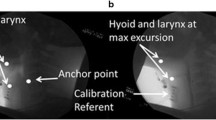Abstract
The aim of this study was to determine whether measures of hyoid velocity increase when swallowing liquids of thicker consistency at a constant volume. A gender-balanced sample of 20 healthy young participants (mean age 31.5) each swallowed 3 boluses of 5 ml volume in 3 consistencies (ultrathin, thin, and nectar-thick barium). Using frame-by-frame tracking of hyoid position, we identified the onset and peak of the hyoid movement and derived measures of velocity (i.e., distance in anatomically normalized units, i.e., % of the C2-4 vertebral distance, divided by duration in ms) for the X, Y, and XY movement directions. Peak hyoid velocity was also identified for each movement direction. Where significant differences were identified, the component measures of hyoid movement distance and duration were further explored to determine the strategies used to alter velocity. The results showed increased velocities and higher peak velocities with the nectar-thick stimuli compared to thin and ultrathin stimuli. This was achieved by a primary strategy of larger hyoid movement distances per unit of time when swallowing nectar-thick liquids. These results point to one mechanism by which thickened liquids may contribute to improved airway protection by facilitating more timely laryngeal vestibule closure.




Similar content being viewed by others
References
Inamoto Y, Saitoh E, Okada S, Kagaya H, Shibata S, Ota K, Baba M, Fujii N, Katada K, Wattanapan P, Palmer JB. The effect of bolus viscosity on laryngeal closure in swallowing: kinematic analysis using 320-row area detector CT. Dysphagia. 2013;28:33–42.
Inamoto Y, Fujii N, Saitoh E, Baba M, Okada S, Katada K, Ozeki Y, Kanamori D, Palmer JB. Evaluation of swallowing using 320-detector-row multislice CT. Part II: kinematic analysis of laryngeal closure during normal swallowing. Dysphagia. 2011;26:209–17.
Perlman AL, Vandaele DJ, Otterbacher MS. Quantitative assessment of hyoid bone displacement from video images during swallowing. J Speech Hear Res. 1995;38:579–85.
Pearson WG Jr, Langmore SE, Zumwalt AC. Evaluating the structural properties of suprahyoid muscles and their potential for moving the hyoid. Dysphagia. 2011;26:345–51.
Van Daele D, Engelhardt P, Reinhardt E, Reinhardt J. Swallow characterization based upon hyoid movement. Dysphagia. 2013;28:646.
Molfenter SM, Steele CM. Use of an anatomical scalar to control for sex-based size differences in measures of hyoid excursion during swallowing. J Speech Hear Res. 2014;57:768–78.
Martin-Harris B, Brodsky MB, Michel Y, Castell DO, Schleicher M, Sandidge J, Maxwell R, Blair J. MBS measurement tool for swallow impairment–MBSImp: establishing a standard. Dysphagia. 2008;23:392–405.
Paik NJ, Kim SJ, Lee HJ, Jeon JY, Lim JY, Han TR. Movement of the hyoid bone and the epiglottis during swallowing in patients with dysphagia from different etiologies. J Electromyogr Kinesiol. 2008;18:329–35.
Kim Y, McCullough GH. Maximal hyoid displacement in normal swallowing. Dysphagia. 2008;23(3):274–9.
Kim Y, McCullough GH. Maximal hyoid excursion in poststroke patients. Dysphagia. 2010;25:20–5.
Steele CM, Bailey GL, Chau T, Molfenter SM, Oshalla M, Waito AA, Zoratto DC. The relationship between hyoid and laryngeal displacement and swallowing impairment. Clin Otolaryngol. 2011;36:30–6.
Molfenter SM, Steele CM. Kinematic and temporal factors associated with penetration-aspiration in swallowing liquids. Dysphagia. 2014;29:269–76.
Molfenter SM, Steele CM. Physiological variability in the deglutition literature: hyoid and laryngeal kinematics. Dysphagia. 2011;26:67–74.
Nagy A, Molfenter SM, Peladeau-Pigeon M, Stokely S, Steele CM. The effect of bolus volume on hyoid kinematics in healthy swallowing. Biomed Res Int. 2014. doi:10.1155/2014/738971.
Ueda N, Nohara K, Tanaka N, Kaneko N, Sakai T. A comparison of the maximum hyoid velocity in healthy adults and dysphagic patients. Dysphagia. 2013;28:646.
Ueda N, Nohara K, Kotani Y, Tanaka N, Okuno K, Sakai T. Effects of the bolus volume on hyoid movements in normal individuals. J Oral Rehabil. 2013;40:491–9.
Clark HM. Specificity of training in the lingual musculature. J Speech Lang Hear Res. 2012;55:657–67.
Clark HM. Neuromuscular treatments for speech and swallowing: a tutorial. Am J Speech Lang Pathol. 2003;12:400–15.
Macaluso A, De Vito G. Muscle strength, power and adaptations to resistance training in older people. Eur J Appl Physiol. 2004;91:450–72.
Dantas RO, Kern MK, Massey BT, Dodds WJ, Kahrilas PJ, Brasseur JG, Cook IJ, Land IM. Effects of swallowed bolus variables on oral and pharyngeal phases of swallowing. Am J Physiol. 1990;258:G675–81.
Lof G, Robbins J. Test-retest variability in normal swallowing. Dysphagia. 1990;4:236–42.
Molfenter SM, Steele CM. Variation in temporal measures of swallowing: sex and volume effects. Dysphagia. 2013;28:226–33.
National Dysphagia Diet Task Force, National Dysphagia Diet: Standardization for Optimal Care/American Dietetic Association, 2002.
Fink TA, Ross JB. Are we testing a true thin liquid? Dysphagia. 2009;24:285–9.
Kotrlik JW, Williams HA. The incorporation of effect size in information technology, learning, and performance research. Inf Technol Learn Perform J. 2003;21(1):1–7.
Acknowledgments
This study was supported through doctoral research funding to the second author from the Natural Sciences and Engineering Research Council (Canada) Create CARE program, the Ontario Student Opportunity Trust Fund, and the Ontario Graduate Studies scholarship program. Additional funding support came from National Institutes of Health R01DC011020 to the final author. The authors thank Sarah Hori, Chelsea Leigh, and Clemence Yee for assistance with data collection and analysis and acknowledge the support of the Toronto Rehabilitation Institute—University Health Network, which receives funding under the Provincial Rehabilitation Research Program from the Ministry of Health and Long-term Care in Ontario. The views expressed do not necessarily reflect those of the Ministry.
Conflict of interest
The authors have no conflicts of interest to disclose.
Author information
Authors and Affiliations
Corresponding author
Rights and permissions
About this article
Cite this article
Nagy, A., Molfenter, S.M., Péladeau-Pigeon, M. et al. The Effect of Bolus Consistency on Hyoid Velocity in Healthy Swallowing. Dysphagia 30, 445–451 (2015). https://doi.org/10.1007/s00455-015-9621-6
Received:
Accepted:
Published:
Issue Date:
DOI: https://doi.org/10.1007/s00455-015-9621-6




